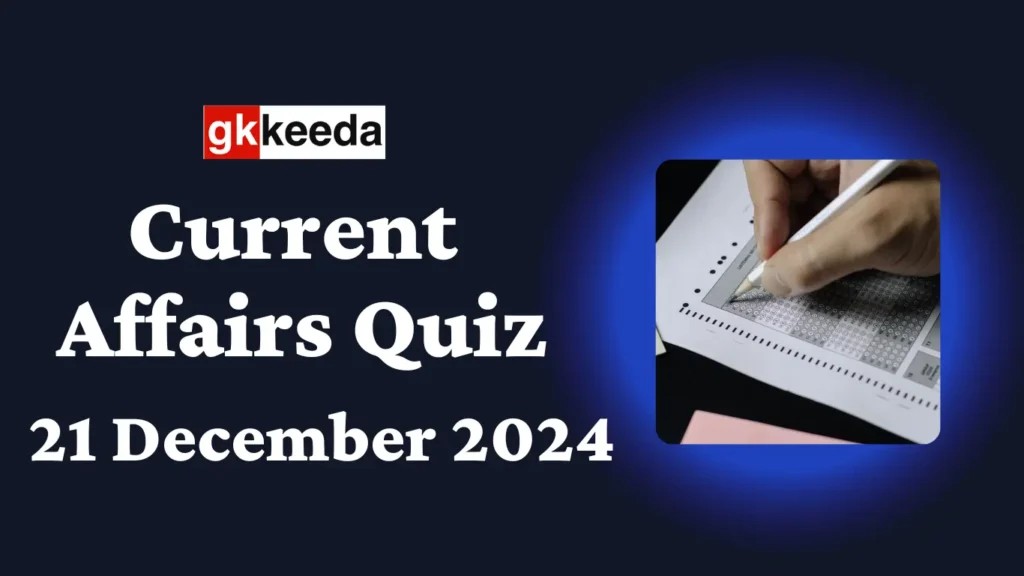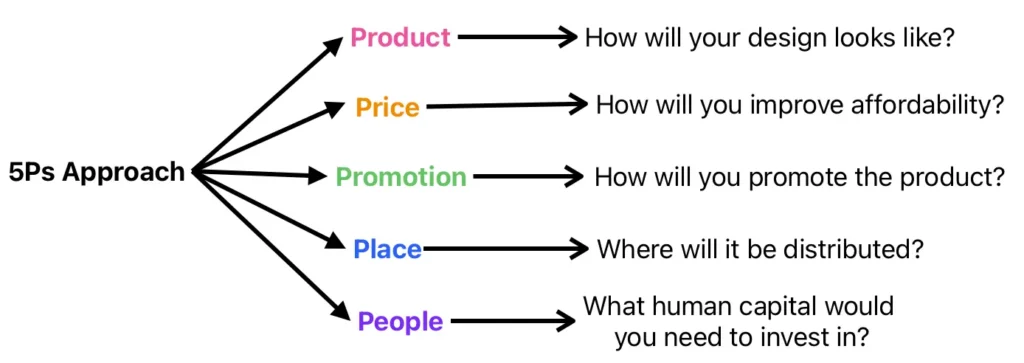Current Affairs Quiz 21 December 2024

Are you looking for questions related to current affairs with answers that cover all the important daily topics from an exam perspective, such as UPSC Prelims Current Affairs, SSC CGL, State’s PCS, and more? If so, you’ve come to the right place! This Current Affairs Quiz will cover MCQ on current affairs.
Topics covered in Today’s Current Affairs Quiz
Q1. On which date is World Meditation Day celebrated?
(A). 20 December
(B). 21 December
(C). 22 December
(D). 24 December
Show Answer
Correct Answer: (B)
Explanation:
Context: Recently, the United Nations General Assembly declared December 21 as World Meditation Day to raise awareness about the benefits of meditation, emphasize the right to physical and mental health.

What is the theme of World Meditation Day 2024?
- “Meditation for the Global Peace and Harmony”.
Importance of celebrating World Meditation Day
- It will serve as a reminder of the importance of nurturing human consciousness and addressing global challenges such as conflict, climate change, etc through inner peace and compassion.
Q2. Sahitya Akademi Award is given in which of the following languages:
(1). English
(2). Rajasthani
(3). Nepali
(4). Dogri
Which of the following statements given above is/are correct?
(A). 1, 2 & 3 Only
(B). 1, 3 & 4 Only
(C). 2, 3 & 4 Only
(D). All of the above
Show Answer
Correct Answer: (D)
Explanation:
Context: Recently, Sahitya Akademi announced the 2024 Sahitya Akademi Award winners.
What is Sahitya Akademi?
- It is an autonomous institution under the Ministry of Culture, inaugurated in 1954 and registered under the Societies Registration Act 1860.
In how many languages is the Sahitya Akademi Award given?
- Sahitya Akademi Awards are given in 24 languages (22 Scheduled languages listed in the Indian Constitution, along with English, and Rajasthani).
Who are the winners of the 2024 Sahitya Akademi Awards?
Suggestion: There is no need to remember all the names, as it is not cost-effective, especially from the perspective of the UPSC CS Prelims. Just remember one name that is more prominent in the news: Easterine Kire, for her English novel Spirit Nights.
Q3. District-Level Climate Risk Assessment Report for India: Mapping Flood and Drought Risks Using IPCC Framework released by
(A). Indian Meteorological Department (IMD)
(B). National Disaster Management Authority (NDMA)
(C). IIT Guwahati with Centre for Study of Science, Technology, and Policy (CSTEP), Bengaluru
(D). Centre for Science and Environment (CSE)
Show Answer
Correct Answer: (C)
Explanation:
Context: Recently, the District-Level Climate Risk Assessment Report for India: Mapping Flood and Drought Risks Using IPCC Framework released by IIT Guwahati, in collaboration with IIT Mandi and the Centre for Study of Science, Technology, Policy (CSTEP), Bengaluru.
Important Findings in the Report
Flood Risk Assessment:
- 51 districts are in the “Very High” flood risk category 118 districts are in the “High” flood risk category.
- 85% of these districts are located in Assam, Bihar, Uttar Pradesh, West Bengal, Gujrat, Odisha, and Jammu & Kashmir.
Drought Risk Assessment:
- 91 districts are in the “Very High” drought risk category 188 districts are in the “High” drought risk category.
- 85% of these districts are located in Bihar, Assam, Jharkhand, Odisha, Uttar Pradesh, Maharashtra, West Bengal, Karnataka, Tamil Nadu, Chhattisgarh, Kerala, Uttarakhand, and Haryana.
Dual Risks of Flood and Drought
- 11 districts fall into the “Very High” risk category for both floods and droughts.
Q4. Consider the following statements regarding the Banking Regulation Act of 1949:
(1). Empowering the Reserve Bank of India (RBI) to issue licenses to banks to operate.
(2). Empowering RBI to control board composition, appointment of directors, and management practices.
(3). Laying down guidelines for the maintenance of minimum reserves by banks.
Which of the following statements given above is/are correct?
(A). 1 & 2
(B). 1 & 3
(C). 2 & 3
(D). 1, 2 & 3
Show Answer
Correct Answer: (D)
Explanation:
Context: The Banking Regulation Act of 1949 marks its 75 anniversary.
Important provisions under the Banking Regulation Acts, 1949
- Regulation of Banking Companies: It empowers RBI to grant or revoke licenses for banking operations, branch expansion, etc.
- Maintenance of Reserves: Banks are required to maintain a certain percentage of their net demand and time liabilities as Cash Reserve Ratio (CRR) and Statutory Liquidity Ratio (SLR).
- Management of Banks: Qualifications of Directors and restrictions of employment of Directors who have substantial interests in other business.
- Regulation of Accounts and Audit: RBI has the authority to conduct audits and inspections of banks.
- Control over merger: RBI approval is required for mergers or amalgamations of banks.
- Prohibition over certain activities: Banks are prohibited from trading in goods directly.
Q5. Agritech for Women Farmer: A Business Case for Inclusive Growth” report released by
(A). World Economic Forum (WEF)
(B). World Bank (WB)
(C). Organization for Economic Cooperation and Development (OECD)
(D). Food and Agriculture Organization (FAO)
Show Answer
Correct Answer: (A)
Explanation:
Context: Recently, the World Economic Forum released a report titled “Agritech for Women Farmer: A Business Case for Inclusive Growth”.
Important Findings in the Report
- Need for gender-inclusive Agritech: Women constitute nearly 50% across commercial value chains such as cotton, sugarcane, tea, coffee, and cashews. Despite this, women earn up to 60% less than men.
- Challenges women farmers face in adapting AgriTech: Sociocultural barriers, limited access to formal credit due to limited land ownership, and literacy barriers.
- Lack of comprehensive gender-disaggregated data in accessing and using AgriTech services.

Q6. Consider the following cases:
(1). Jaggo & Ors. vs. Union of India & Ors.
(2). State of Karnataka vs. Uma Devi
(3). Vinod Kumar and Ors. Etc. vs. Union of India & Ors.
To which issue are the above cases related?
(A). Triple Talaq
(B). Misuse of temporary contracts in public institutions
(C). Subcategorisation of SC/ST Reservation
(D). Doctrine of Basic Structure
Show Answer
Correct Answer: (B)
Explanation:
Context: The Supreme Court (SC) of India in Jaggo & Ors. vs. Union of India & Ors case has recently criticized the misuse of temporary contracts by public institutions, avoiding regular employment obligations by repeatedly outsourcing temporary positions, creating a cycle of worker exploitation.
Cases related to Long-term temporary employment in public institutions
- Jaggo & Ors. vs. Union of India & Ors.
- State of Karnataka vs. Uma Devi
- Vinod Kumar and Ors. Etc. vs. Union of India & Ors.
Q7. Which of the following statements is correct regarding Adjournment Sine Die?
(A). It permanently dissolves the House, ending all pending business.
(B). It terminates a sitting of Parliament for an indefinite period.
(C). The Power of Adjournment Sine Die lies with the President.
(D). It concludes the current session, automatically transferring all pending business to the next session.
Show Answer
Correct Answer: (B)
Explanation:
Context: The Winter Session of Parliament was an Adjourned Sine Die recently.
Adjourned Sine Die means
- Terminate the sitting of the Parliament without fixing a date for the next meeting.
Who has the power of Adjournment Sine Die?
- Presiding Officer of the House.
You might be confusing it with Prorogation. Allow me to explain
Difference between Adjournment Sine Die and Prorogation
- Adjournment Sine Die temporarily suspends the sitting of the House without naming a day for reassembly. However, it does not terminate the session itself. The session remains alive, and pending business can resume if the House is reconvened within the same session.
- In contrast, prorogation of the House formally ends the session, at which point some pending business (e.g., unfinished bills) may lapse or carry forward based on parliamentary rules.
Q8. Consider the following statements regarding the Indian palm squirrels:
(1). They build nests by making burrowing in the ground.
(2). They store their food materials like nuts and seeds in the ground.
(3). They are omnivorous.
How many of the above statements are correct?
(A). Only one
(B). Only two
(C). All three
(D). None
Show Answer
Correct Answer: (B)
Explanation:
Context: The Indian palm squirrels were in the news.
This question was asked in UPSC CS Prelims 2023.
Some facts about Indian palm squirrels
- They build their nests in the treetops using grass and branches. Hence, statement 1 was incorrect.
- They are omnivorous, consuming both fruits and nuts, as well as eggs, small birds, larvae, and insects. Hence, statements 2 & 3 are also correct.
- Squirrels aggressively protect their food, which they store in treetops.
Q9. Consider the following statements regarding the Indian Railways:
(1). Most of the Indian Railways’ earnings come from its freight services.
(2). The installation of the KAVACH system has been completed across the entire track.
(3). Over the past decade, the average freight train speed has stayed at 25 km/h.
Which of the following statements given above is/are correct?
(A). 1 & 2
(B). 2 & 3
(C). 1 & 3
(D). 1, 2 & 3
Show Answer
Correct Answer: (C)
Explanation:
Context: The Standing Committee on Railways published a report titled “Report Focusing on Railway Modernization and Financial Sustainability”.
Important findings in the report
- Most of the Indian Railways’ earnings come from its freight services. In 2023-24, ₹ 1,68,296/- revenue was earned from freight and ₹ 70,693.33 was earned from passenger services.
- Average freight train speed has remained stagnant at 25 km/hr over the past decade.
- Kavach system has been implemented over a 1465 km route on the South Central Railway and 80km in the North Central Railway.
Recommendations given in the report
- Increase revenue by reviewing AC class fare and boost non-fare revenue to 20% by 2030.
- Fast-track infrastructure development by streamlining land acquisition, and complete Dedicated Freight Corridors.
- Enhance safety and modernization by eliminating unmanned crossing and expedite Kavach system deployment.
Q10. With reference to the Minimum Support Price (MSP) in India, consider the following statements:
(1). MSP is announced by the Ministry of Agriculture based on the recommendations of the Commission for Agricultural Costs and Prices (CACP).
(2). It is declared for all food grains, horticultural crops, and commercial crops grown in India.
(3). MSP is legally binding for all private buyers to procure crops from farmers at or above the declared price.
(4). MSP ensures that farmers are compensated if the open market prices of their produce fall below the declared price.
Which of the following statements given above is/are correct?
(A). 1, 2 & 4
(B). 2 & 4
(C). 1 & 4
(D). 1, 3 & 4
Show Answer
Correct Answer: (C)
Explanation:
Context: Recently, the Cabinet approved the hike of Copra’s MSP up to ₹ 420/- to ₹ 12000/- per quintal for 2025.
About MSP in India
- MSP is announced by the Government of India based on the recommendations of the CACP.
- MSP is announced for 22 crops which have 14 Kharif crops, 6 Rabi crops, and 2 commercial crops.
- It provides a safety net to farmers when market prices fall below the announced price.
- MSP is not legally binding on private buyers. It applies mainly to government procurement agencies.

No Comment! Be the first one.